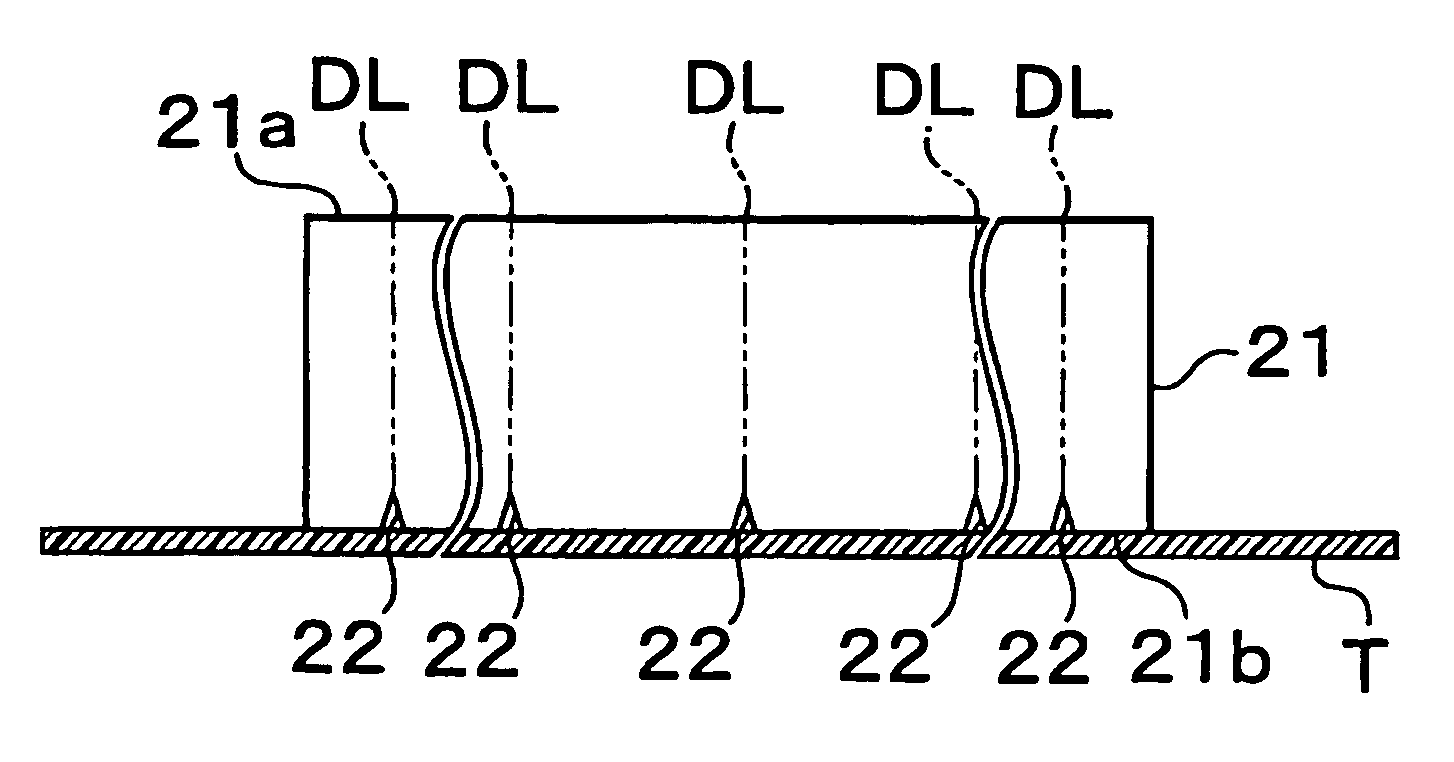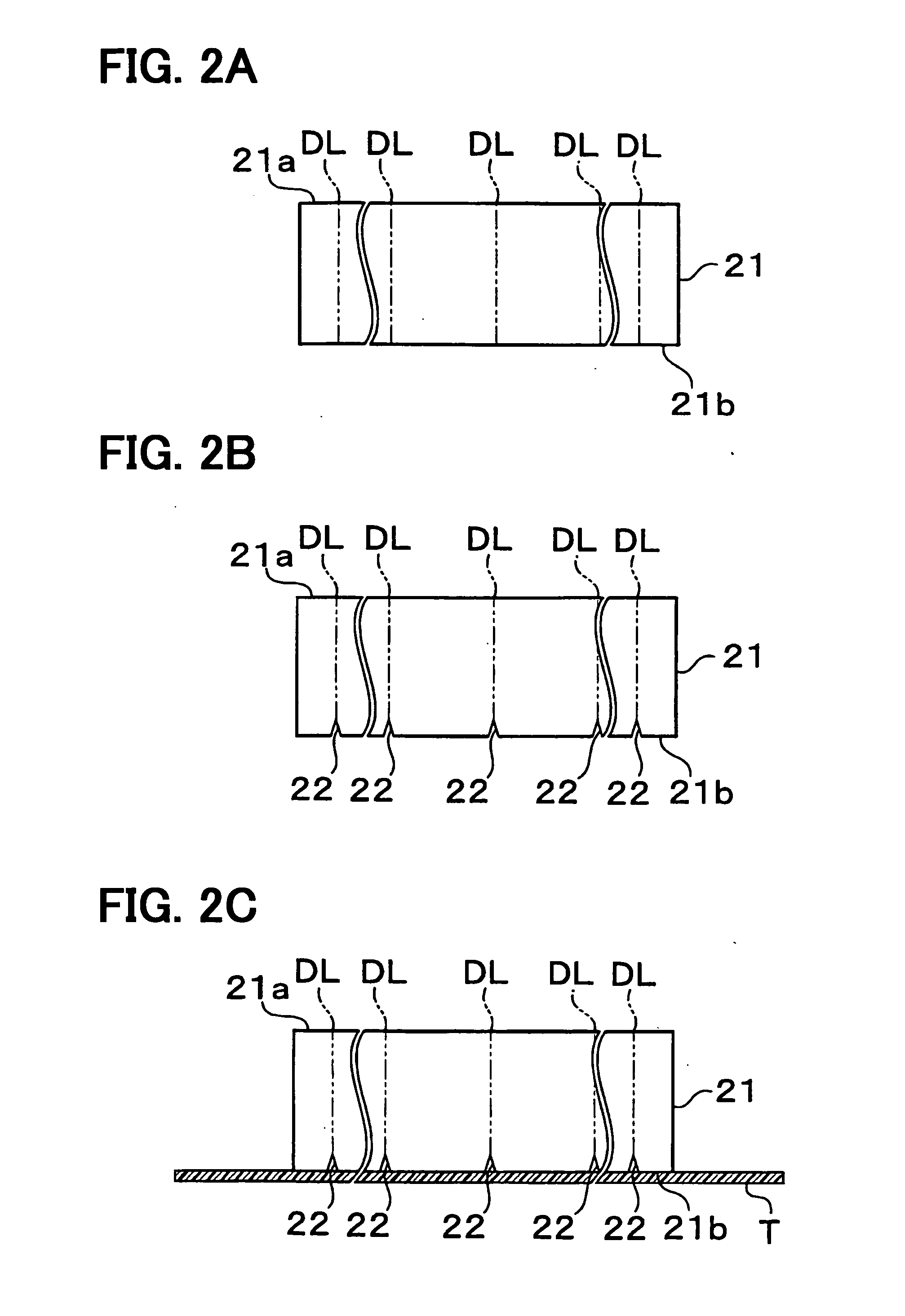Semiconductor device and dicing method for semiconductor substrate
a semiconductor substrate and semiconductor technology, applied in the direction of metal working equipment, manufacturing tools, welding/soldering/cutting articles, etc., can solve the problems of thermal distortion, optical damage, cracks in its portion, etc., to improve the yield of semiconductor chips, reliably develop cracks by small force, and reliably divide the semiconductor substrate
- Summary
- Abstract
- Description
- Claims
- Application Information
AI Technical Summary
Benefits of technology
Problems solved by technology
Method used
Image
Examples
first embodiment
Mode
[0077] Embodiment modes for applying a laser dicing method and a semiconductor wafer to a dicing process of the semiconductor wafer will next be explained on the basis of the respective drawings.
[0078] A laser dicing method and a semiconductor wafer in accordance with a first embodiment mode will be explained on the basis of FIGS. 1A to 3C. FIG. 1A illustrates a cross-sectional view (a section of line IA-IA shown in FIG. 1B) showing the construction of the semiconductor wafer in accordance with this first embodiment mode. FIG. 1B shows a bottom (rear) view seen from a line arrow IB shown in FIG. 1A. Further, FIGS. 2A to 3C illustrate cross-sectional views showing the construction of the semiconductor wafer in each step constituting a dicing process in accordance with this first embodiment mode. FIG. 2A shows the semiconductor wafer before a groove portion forming step. FIG. 2B shows the semiconductor wafer after the groove portion forming step. FIG. 2C shows the semiconductor w...
second embodiment
Mode
[0093] Next, a laser dicing method in accordance with a second embodiment mode will be explained on the basis of FIGS. 4A to 4C. FIGS. 4A to 4C illustrate cross-sectional views showing the construction of a semiconductor wafer in each step constituting a dicing process in accordance with this second embodiment mode. FIG. 4A shows the semiconductor wafer during the reforming layer forming step. FIG. 4B shows the semiconductor wafer after the groove portion forming step. FIG. 4C shows the semiconductor wafer after the expand tape sticking step.
[0094] This second embodiment mode differs from the first embodiment mode in that the groove portion forming step arranged before the reforming layer forming step in the first embodiment mode is arranged after the reforming layer forming step.
[0095] As shown in FIG. 4A, in this second embodiment mode, with respect to the semiconductor wafer 21 forming no groove portion 22 therein, a laser beam is first irradiated to the surface 21a of the ...
third embodiment
Mode
[0101] Next, a laser dicing method in accordance with a third embodiment mode will be explained on the basis of FIGS. 5A to 5D. FIGS. 5A to 5D illustrate cross-sectional views showing the construction of a semiconductor wafer in each step constituting a dicing process in accordance with this third embodiment mode. FIG. 5A shows the semiconductor wafer after the groove portion forming step. FIG. 5B shows the semiconductor wafer during the reforming layer forming step. FIG. 5C shows the semiconductor wafer seen from a line arrow VC shown in FIG. 5B. FIG. 5D shows the semiconductor wafer after the expand step.
[0102] This third embodiment mode differs from the first embodiment mode in that the groove portion 22 formed on the rear face 21b of the semiconductor wafer 21 in the first embodiment mode is formed as a groove portion 24 on the surface 21a of the semiconductor wafer 21. The groove portion 24 formed in this third embodiment mode differs from the groove portion 22 formed in t...
PUM
| Property | Measurement | Unit |
|---|---|---|
| Distance | aaaaa | aaaaa |
| Thickness | aaaaa | aaaaa |
| Force | aaaaa | aaaaa |
Abstract
Description
Claims
Application Information
 Login to View More
Login to View More - R&D
- Intellectual Property
- Life Sciences
- Materials
- Tech Scout
- Unparalleled Data Quality
- Higher Quality Content
- 60% Fewer Hallucinations
Browse by: Latest US Patents, China's latest patents, Technical Efficacy Thesaurus, Application Domain, Technology Topic, Popular Technical Reports.
© 2025 PatSnap. All rights reserved.Legal|Privacy policy|Modern Slavery Act Transparency Statement|Sitemap|About US| Contact US: help@patsnap.com



